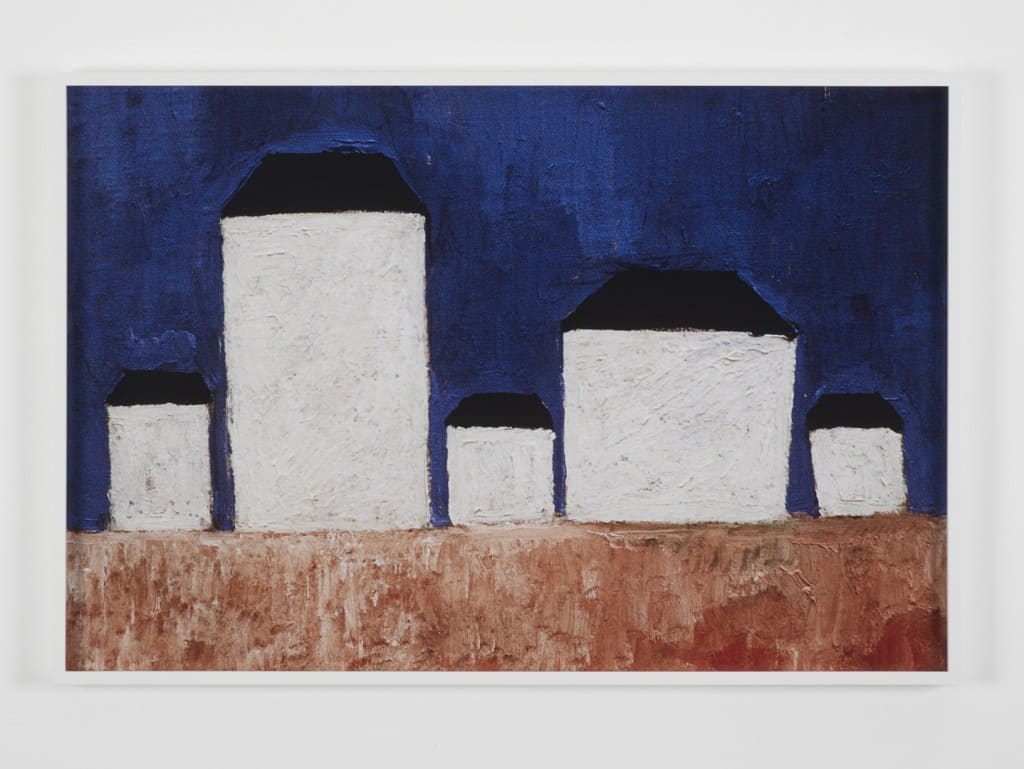Goshka Macuga, born in Warsaw and living in London, is one of the most prominent figures of European art scene. Nominated to Turner Prize in 2008, she carries out her projects in galleries all over the world, and last year her tapestry Of what is, that it is; of what is not, that it is not was shown in Fredericianum during Documenta 13. in Kassel.
In her most recent exhibition in Kate MacGarry Gallery in London, Report from the Exhibition, Goshka Macuga created a box-within-a-box composition – she treated exposition as a paraphrase of two other exhibitions, which had taken place in Hotel Polonia in Warsaw: Kasimir Malevich’s in 1927 (to commemorate this event one of the hotel’s halls is named after him) as well as exhibition of Eustachy Kossakowski’s photographs in 2010.
Kossakowski’s photographic series, entitled precisely Report from the Exhibition, are frames of fragments of Malevich’s paintings, which this documentarian of artistic life of the 60s and 70s had the chance to see in Stedelijk Museum in 1989. Kossakowski had already been working for Centre George Pompidou and was invited as an accredited photographer to make a report from the exhibition in Amsterdam. However, instead of focusing on the entourage of the opening, the photographer, fascinated by Malevich’s extraordinary compositions, created his own interpretation of the works. This way, a collection of several dozen of colourful art photographs, which focused on chosen fragments of paintings, was created.

EUSTACHY KOSSAKOWSKI, Report from the Exhibition, 1989/2010 Colour photograph of the painting Head of the Boy by Kazimir Malevich (fragment 5), 1928-1929, oil on board, 72 x 54 cm, courtesy of Kate Macgarry Gallery.
Goshka Macuga has chosen ten photographs for the exhibition, in which Kossakowski captured fragments of six paintings by Malevich: Head of a boy (1928-9), A Portrait of Ivan Vasilevich (1913), Cow and Violin (1913-4),The Accounting Lectern and Room (1913-4), Peasent Women in the Field (1928-32). The boundary between the abstract and the realistic has been blurred, this way individual deconstructed elements become more dramatic highlighting the artistic genius of the Russian master.
Macuga in a way repeated the process leading from fascination in Malevich’s artistic work through its appropriation, to creating its artistic reinterpretation. The artist invokes past events and at the same time she holds a vivid conversation with history, adding her own significance to the meanings that had already piled up. A double recurrence takes place here – the late works of Russian supremacist, mediated in the photographs, are juxtaposed with four mirrors, on which Macuga created compositions modelled on Malevich’s diagrams of 1922. The viewer first looks at Malevich’s fragmented paintings, and then sees them reflected in a mirror. The distance created between the viewer and a work of art becomes deeper and refers to the problem of exhibiting works of art history in contemporary galleries. The boundary between the things that are real and the things that are reflections of reality becomes a crucial power multiplying perceptual noise. This unusual duality, or even a triple applied by Macuga in the cognitive process makes us reflect on the notion of authorship as well as on the history of mutual influences and correlations. It is worth relating to the artistic technique of appropriation whose representatives, with the use of the medium of photography and collage, annex other artists’ works to reveal their hidden meanings. Following this lead, in the context of Kossakowski’s cycle, it is impossible not to refer to the works of American photographer Louise Lawler, which depict well-known works of art in the context of their surroundings, museum and private space as well. The role of the elements which take the works out of context in Macuga’s case is taken by the mirrors placing the viewer’s body between the work and his eyesight.
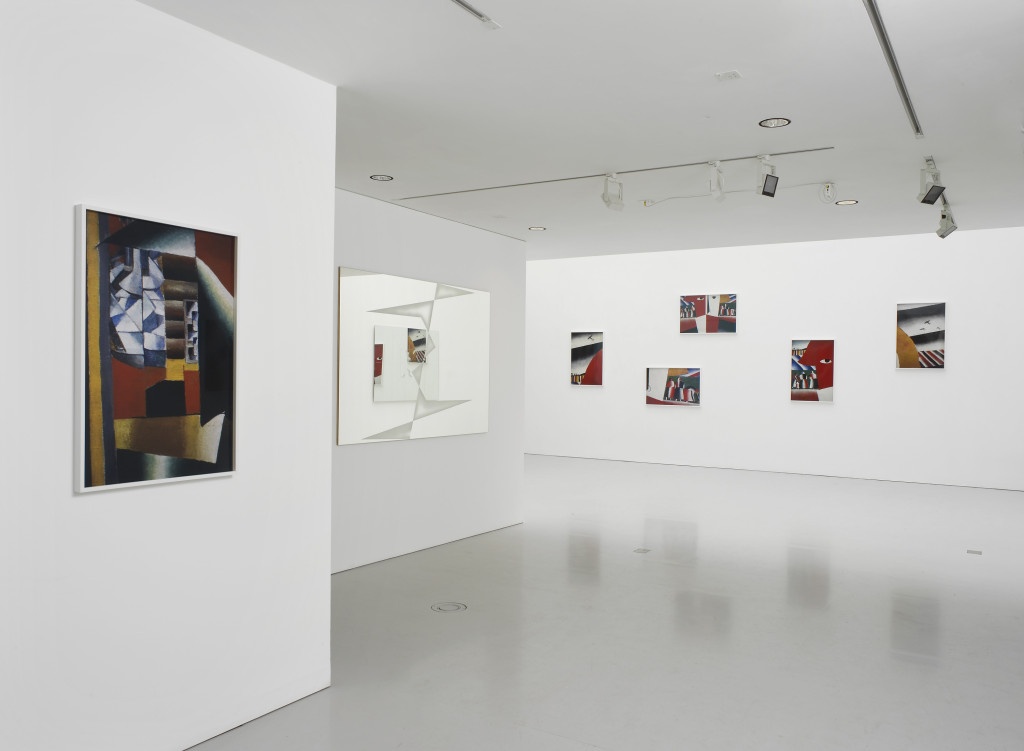
Installation views, EUSTACHY KOSSAKOWSKI & GOSHKA MACUGA, Report from the Exhibition, Kate MacGarry, 2014
Contemporary fascination with everything connected with bringing past things back to life (retro, vintage, manual work, return to nature) probably stems from satiety with modernity itself and the necessity to realize utopian visions of modernity. While modernism was the time of plans and projects – it directed our attention a step further than the here-and-now, in modernity we are, as Boris Groys puts it, comrades of time. We are doomed to lack of faith in the future, torn out from the past and immersed in the excess of constant becoming, being and reinterpretation. “Today, we are stuck in the present as it reproduces itself without leading to any future. We simply lose our time, without being able to invest it securely, to accumulate it, whether utopically or heterotopically”– as Groys noticed in his text Comrades of Time.
The condition of contemporary art originates from boredom, which Martin Heidegger interprets as a primary condition of the appearance of the present time. It seems that aiming at verifying modernist projects, it is immersed in non-materiality. It analyses time and its absurd, or revises the archives of art. Goshka Macuga has been consistently carrying out the second option for years, walking the path of “cultural archeology”, which she has chosen herself. As she has put herself, she is not only an artist, but she performs various functions, from curator to magician.

GOSHKA MACUGA, Drawing no 4. ‘Path of Movement of a Point’ after K. Malevich (1922), 2003, sand blasted mirror, courtesy of Kate MacGarry Gallery.
Macuga likes reaching for the works of other artists; her own work often involves minor interventions in the structure of more or less well-known works, their deconstruction by the change of context, digging through the stories that grew around the works and retelling them. For that reason, we may consider Macuga a modern shaman, using the experiences of ancestors to show the incredibility of the world, its constant flow. At the same time, she does not escape the present time, though she is not its hostage. She is the comrade of time that passed, and which may be invoked, charmed and looped repeatedly.
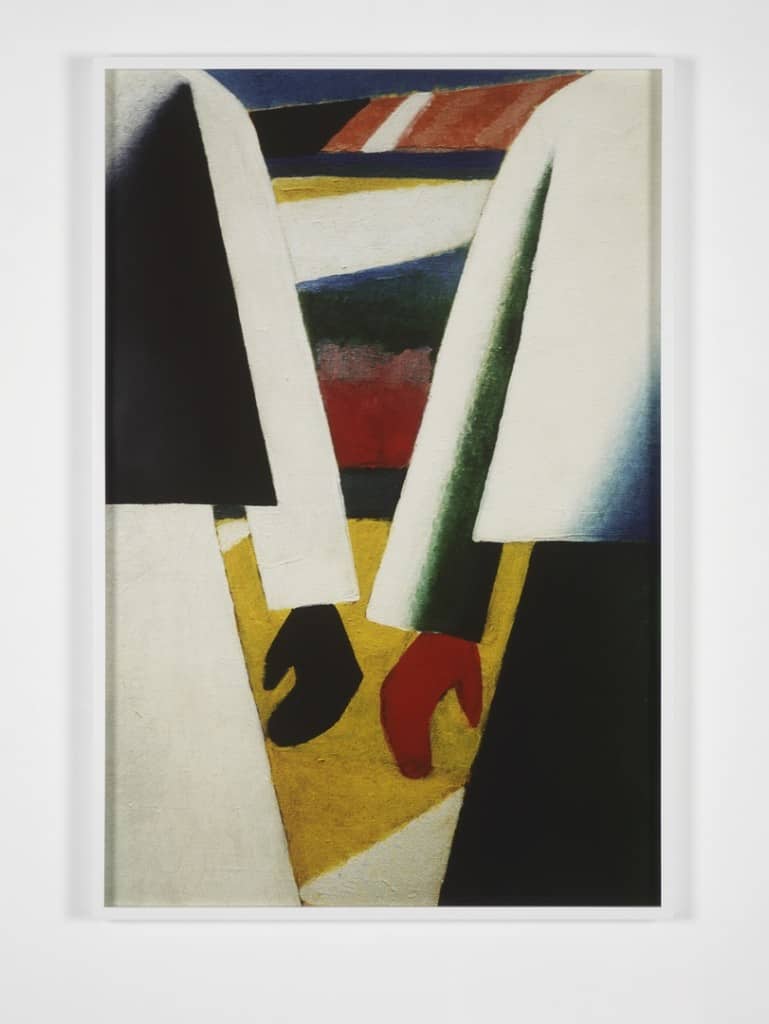
EUSTACHY KOSSAKOWSKI, Report from the Exhibition, 1989/2010, Photograph of the painting Girls in the Field by Kazimir Malevich (fragment 2), 1928- 1929, oil on canvas, 106 x 125 cm, courtesy of Kate Macgarry Gallery
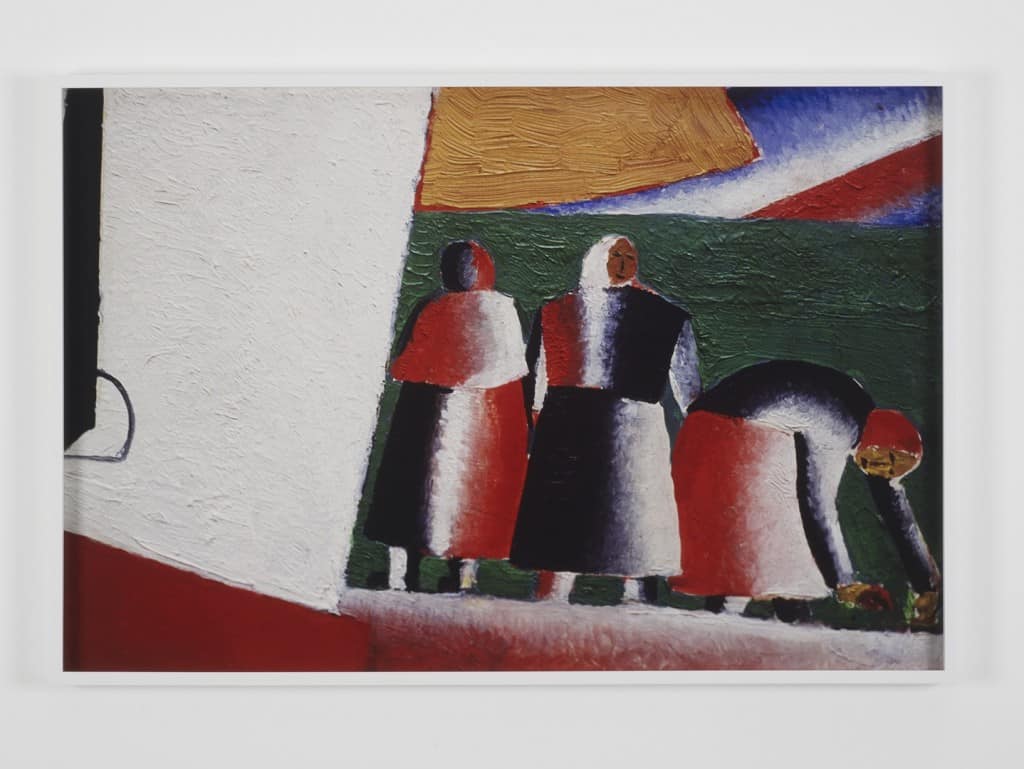
EUSTACHY KOSSAKOWSKI, Report from the Exhibition, 1989/2010, Photograph of the painting Head of the Boy by Kazimir Malevich (fragment 4), 1928-1929, oil on board, 72 x 54 cm, courtesy of Kate MacGarry Gallery.
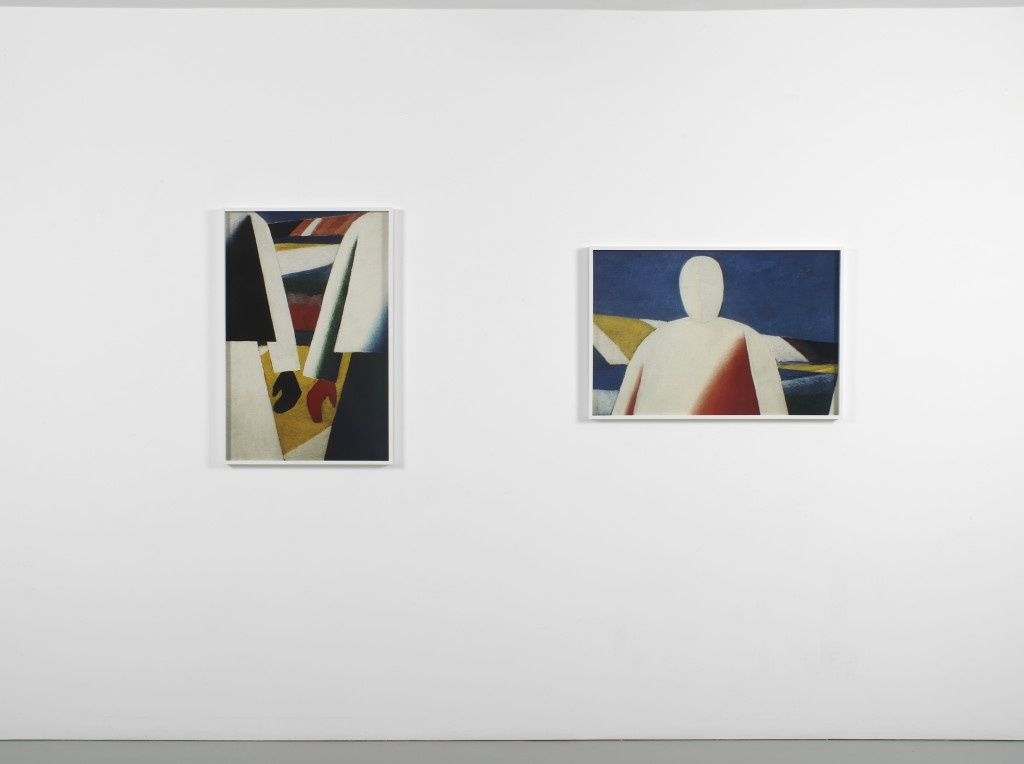
Installation views, EUSTACHY KOSSAKOWSKI & GOSHKA MACUGA, Report from the Exhibition, Kate MacGarry, 2014
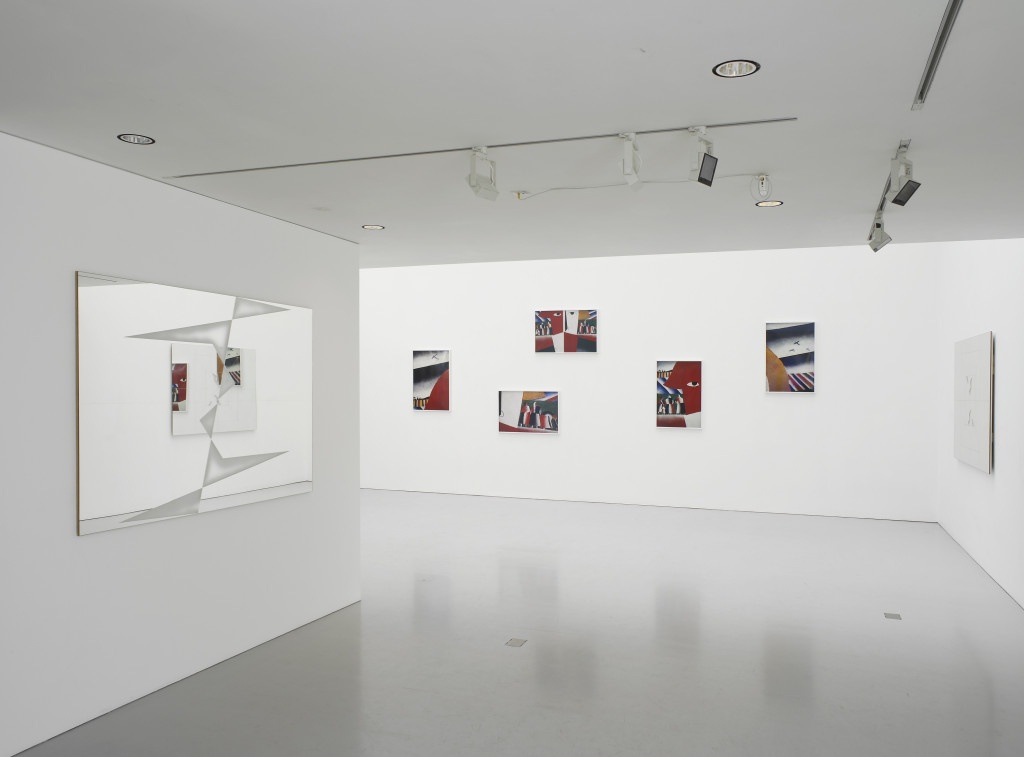
Installation views, EUSTACHY KOSSAKOWSKI & GOSHKA MACUGA, Report from the Exhibition, Kate MacGarry, 2014


